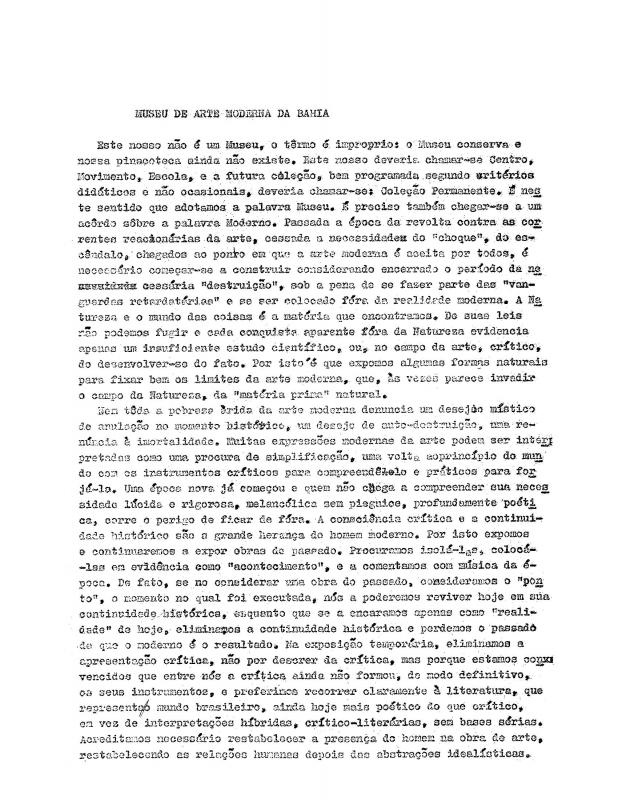As regards the MASP, see the essay by Pietro Maria Bardi “20 anos do Museu de Arte de São Paulo” [doc. no. 1111187]. The Italian architect Lina Bo Bardi [née, Achillina Bo, 1914–92] immigrated to Brazil after the Second World War and settled there with her husband in the early 1950s. After the MASP was founded, Lina took charge of HABITAT, the MASP’s art magazine that published articles such as “Instituto de Arte contemporânea” by Jacob Ruchti (no. 3); and “Plásticas novas” by Leopold Haar, who was a member of the Grupo Ruptura (n. 5). The following year, in 1951, Lina and her husband started the industrial design course at the museum’s Contemporary Art Institute, IAC (Instituto de Arte Contemporânea), where she also worked as a teacher. She lived in Salvador (Bahia) from 1959 to 1964, where she was the director of the MAMB. As had happened at the MASP in São Paulo—where she was in charge of program planning and teaching activities—her work at the MAMB consisted of organizing art history exhibitions and shows for contemporary and international artists representing various movements, and re-evaluating the traditional culture of the Brazilian “northeast.” On this subject, see Lina’s articles “Formas como escultura” [doc. no. 1110858]; “Museu de Arte Moderna da Bahia” [doc. no. 1110860]; and “Técnica e arte” [doc. no. 1110861].
The IAC-MASP (Instituto de Arte Contemporânea del Museu de Arte de São Paulo) was one of the first attempts to organize the teaching of industrial design in Brazil. It operated from 1951 to 1953—under the direction of the architect Lina Bo Bardi—and was charged with training artists to work in the burgeoning Brazilian industrial sector. Ever since it was founded in 1947, one of the MASP’s goals was to create a collection of key works of western art. The museum fulfilled its pedagogical mission by presenting educational shows, lectures, classes, and exhibitions of works by contemporary artists such as Le Corbusier, Alexander Calder, Max Bill, and Paul Klee, among others.
The IAC was inspired by the philosophy of the Bauhaus, which held that industry is a powerful vehicle for the expression of modern art, and that machine production offers new challenges for artistic creativity and is therefore a liberating influence (as posited by László Moholy-Nagy). The IAC undoubtedly stimulated subsequent theoretical ideas in the field of concrete art (the Grupo Ruptura in São Paulo, among others) and contributed to the development of important Brazilian graphic designers such as Alexandre Wollner, Maurício Nogueira Lima, and Antônio Maluf.




